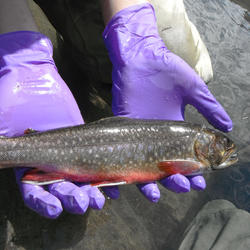New Hepatitis B Virus Discovered in White Sucker (Catostomus commersonii)
Collecting a liver tissue sample from a wild-caught white sucker
The first known hepatitis B virus to infect fish (white sucker; Catostomus commersonii) has been discovered by U.S. Geological Survey (USGS) scientists.

These findings, with the full genetic sequence of the virus, were published in the Journal of Virology. This newly discovered virus is in the family Hepadnaviridae, which include similar viruses in mammals and birds. This virus is unique from other known hepadnaviruses and likely represents a new genus. In mammals, including humans, these viruses are typically associated with liver diseases including fibrosis, cirrhosis, and cancer. Human hepatitis B virus has a specific protein that is associated with cancer induction, and this tumor-associated protein is not present in the new hepatitis B virus isolated from white suckers.
White suckers inhabit river systems in the Midwestern and Northeastern United States. As bottom-feeders, they are continuously exposed to contaminants in river sediments and are used as an indicator species in assessing the health of their aquatic environments. The incidence of liver tumors in these fish has been used as an indication of toxic contaminant exposure. It is not known if this newly identified virus is associated with tumors or liver disease in these fish, but it may be a risk factor.
This research was funded by the USGS Ecosystems Mission Area’s Environmental Health Program (Contaminant Biology and Toxic Substances Hydrology).

Below are other science projects associated with this project.
Immunomodulation Science Team
Fishing and Hunting Integrated Science Team
Below are publications associated with this project.
Characterization of a novel hepadnavirus in the white sucker (Catostomus commersonii) from the Great Lakes Region of the USA
The first known hepatitis B virus to infect fish (white sucker; Catostomus commersonii) has been discovered by U.S. Geological Survey (USGS) scientists.

These findings, with the full genetic sequence of the virus, were published in the Journal of Virology. This newly discovered virus is in the family Hepadnaviridae, which include similar viruses in mammals and birds. This virus is unique from other known hepadnaviruses and likely represents a new genus. In mammals, including humans, these viruses are typically associated with liver diseases including fibrosis, cirrhosis, and cancer. Human hepatitis B virus has a specific protein that is associated with cancer induction, and this tumor-associated protein is not present in the new hepatitis B virus isolated from white suckers.
White suckers inhabit river systems in the Midwestern and Northeastern United States. As bottom-feeders, they are continuously exposed to contaminants in river sediments and are used as an indicator species in assessing the health of their aquatic environments. The incidence of liver tumors in these fish has been used as an indication of toxic contaminant exposure. It is not known if this newly identified virus is associated with tumors or liver disease in these fish, but it may be a risk factor.
This research was funded by the USGS Ecosystems Mission Area’s Environmental Health Program (Contaminant Biology and Toxic Substances Hydrology).

Below are other science projects associated with this project.
Immunomodulation Science Team
Fishing and Hunting Integrated Science Team
Below are publications associated with this project.



